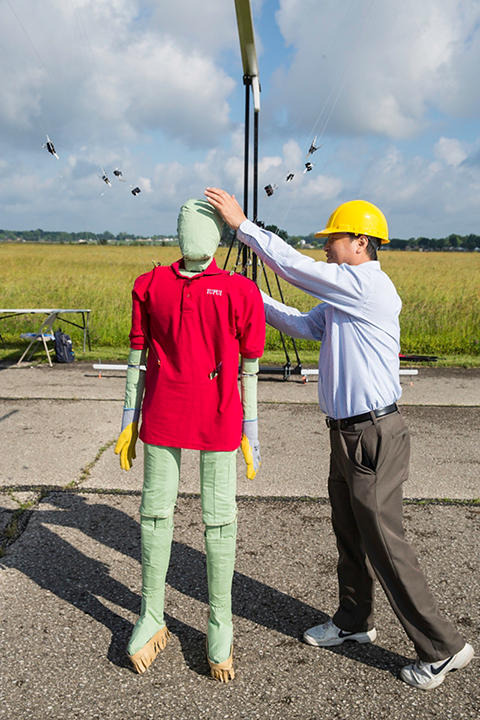LANGUAGES

- Collaborative Safety Research Center to Focus Research on the transition to Automated Vehicle and Connected Vehicle Technologies
- New $35 Million Commitment Extends CSRC to 2020’s
- Continued program support for research at the University of Toronto
TORONTO, ON., (September 4, 2014) – With the goal of making tomorrow’s driving safer, Toyota’s Collaborative Safety Research Center (CSRC) announced that it is significantly expanding its mission to advance automotive safety research, with a new focus on the challenges and opportunities that evolving vehicle technologies will present over the next decade.
Thanks to a new $35 million commitment that extends the centre’s effort to the 2020s, CSRC will concentrate on supporting a safe transition to the future of mobility, particularly through emerging automated- and connected-vehicle technologies. As part of this effort, researchers intend to explore the complex relationship between future mobility and broader social trends, such as the growth of networked “Smart Homes” and the so-called “Quantified Self” associated with the rise in wearable devices.
In Canada, CSRC is entering another year of its three year commitment to the University of Toronto in a study to determine what types of feedback alerts (individually and combined) are most effective in helping inhibit risky behaviours. The study also includes research on when feedback can become a potential distraction, what types of individuals are more susceptible to feedback, how drivers adapt to feedback over time, and whether the safety benefits of feedback persist even when it is no longer available.
“At Toyota, we believe in the fundamental principle that when good ideas are shared, great things can happen,” said Osamu Nagata, President and CEO of Toyota Motor Engineering and Manufacturing North America, Inc. (TEMA), who made the announcement at Toyota’s 2014 Advanced Safety Seminar in Ann Arbor, Mich. “As new automotive technologies continue to evolve, CSRC is committed to working with its partners across the industry and beyond to help realize a future of mobility that is safer and greener than today.”
“CSRC’s newly expanded mission recognizes that the emergence of advanced technologies is radically reshaping the transportation landscape,” said Chuck Gulash, Director of CSRC. “Thanks to these exciting automated and connected vehicle technologies, drivers and their vehicles are increasingly working together as teammates and sharing more responsibilities on the road. We hope to help to pave the way for the safe introduction of these new systems, not only by refining the technologies, but also by preparing the drivers who will be using them -- with the continued goal of saving lives.”
The only research centre of its kind in the industry, CSRC partners with leading institutions across North America to help advance safer and more responsible ways of moving people and sharing the results so everyone can benefit. Since 2011, the Center has focused its research on active safety, driver distraction and at-risk traffic populations – including children, teens, pedestrians and seniors – to better understand how to help protect people in crashes and prevent collisions from happening at all.
The Center will continue its work with agencies, policymakers , academics and industry to identify research gaps and to share findings, research tools and analytic models across the automotive industry and beyond.
Three Years of Safety Advances
Over the last three years, CSRC has launched 34 research projects with 17 partner institutions. To date, the Center has completed seven and made significant advances in the areas of human factors, active safety, biomechanics and Big Data – including:
- Developing standardized test procedures for vehicle and pedestrian pre-collision systems, including the worlds-first articulated mannequin that shares the same radar cross-section as a human, enabling regulators and consumers to measure and compare performance across multiple makes and models;
- Conducting a comprehensive scientific study of the potential safety benefits provided by advanced driving technologies, such as pre-collision (PCS) and lane-departure warning (LDW) systems;
- Building on studies examining the changes in physiology and seatbelt fit with age, taking body-scans of a broad range of age and body types and highlighting the continuous need for public education about the importance of proper seatbelt use. ;
- Creating human body finite element models of a child so that engineers can account for differences in child body characteristics when designing vehicle safety systems.
- Developing high speed tools to organize, process and analyze petabytes of naturalistic driving data (known as the Strategic Highway Research Program 2, or SHRP2) and making the tools available to all auto manufactures, suppliers, transportation agencies and research universities that share our goal of better understanding how we can prevent crashes in the future.
CSRC’s first phase of research will conclude in 2016. Research under the new mission will focus on developing human/machine interface (HMI) guidelines for next-generation automated and connected vehicle systems, the optimal user skills to operate these technologies safely and the unique challenges posed by a U.S. vehicle fleet that will likely feature automated and connected vehicles, as well as traditional ones, traveling the same roads.
Following today’s announcement, CSRC staff will begin to engage with stakeholders to identify gaps in knowledge and key research priorities as society begins to transition to the future of mobility.
-30-
Every effort has been made to ensure the product specifications, equipment, and content on this site are accurate based on information available at time of publishing. In some cases, certain changes in standard equipment or options may occur, which may not be reflected online. Toyota Canada reserves the rights to make these changes without notice or obligation.